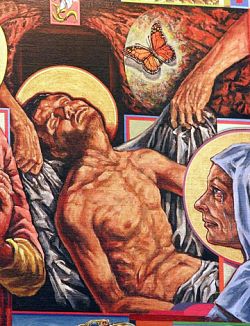Cathedral of the Madeleine rich in Christian symbols

SALT LAKE CITY — It would take a book of considerable length to do a full study of the hundreds of Christian symbols in the Cathedral of the Madeleine – in its Stations of the Cross, its murals, its stained glass windows, its statuary, and its woodwork. At the request of the Intermountain Catholic, retired Salt Lake Tribune photographer Deacon Lynn Johnson took his camera in search of symbols particularly pertaining to Easter and the Eucharist. Some of the elements he found grace this special Easter issue of the Intermountain Catholic, from its front cover with the risen Christ, a detail from a stained glass window, to our Easter section cover, the stained glass image of the risen Christ with a shovel as he came upon Mary Magdalene weeping in the garden. ("She though it was the gardener." Jn: 20) Of course, two of the most popular Christian symbols are those of fish and bread. Deacon Johnson, who conducts tours of the cathedral on a regular basis, said when bread is seen on top of fish it indicates Christ. The basket of bread on the fish’s back indicates the body of Christ – the Eucharist. In the 1950 pamphlet "Symbols in Christian Art: A Popular Explanation," Robert J. Voigt explained: "...animals are used much more frequently than plants, land animals more so than sea-animals, fish more so than other sea-animals." Deacon Johnson found some flying symbols, two of them suggesting resurrection, and one symbolizing the Eucharist. The Religion Facts web site (www.religionfacts.com) relates that the butterfly, "has long been a Christian symbol of resurrection, for it disappears into a cocoon and appears dead, but emerges later far more beautiful and powerful than before." Another, lesser known symbol of the resurrection is the mythical phoenix, which Voigt wrote rises from its own funeral pyre (either one the bird built himself of myrrh and frankincense, or a pyre already existing), and is consumed by the fire. The phoenix resurrects perhaps as a worm from the decaying flesh. "This bird took the nest with the bones and flew it to Heliopolis, Egypt, for burial..." In another version, the phoenix, ready to die, "alights on a funeral pyre. With his flapping wings he ignites the fire in whose glowing flames he is consumed. From the ashes a new bird springs forth to live for the next five centuries. "...The apparent quality of the phoenix’s going down in death so as to rise to a new life on the third day made that bird a symbol of Christ’s resurrection." An even lesser known Christian symbol is the pelican, which is portrayed in many places in the Cathedral of the Madeleine, including under the crucifix above the original main altar of the church. A red stain on the bird’s beak and its habit of pressing its bill against its breast suggests the bird is opening its breast to feel its young, as we are fed with the Eucharist. Voigt relates another version in "Symbols of Christian Art" left to us by St. Jerome... "that serpents kill the young pelicans, but the mother pours her blood over them, bringing them back to life."
© Copyright 2024 The Diocese of Salt Lake City. All rights reserved.

Stay Connected With Us